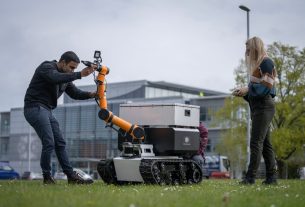ACT NEWS, a growing news-content channel on TikTok, has announced the debut of what it claims to be “the world’s first fully AI automated news edition presented by digital avatar clones.” This cutting-edge approach to news broadcasting could set a new standard in journalism, but it also raises moral and ethical concerns.
The introduction of AI-powered digital clones of renowned journalists, including the likeness of Israeli reporters Miri Michaeli and Amit Segal, represents a paradigm shift in news presentation. While these digital clones will deliver live broadcasts on screen, the correspondents can work on stories in the field simultaneously. This concept aims to engage diverse audiences worldwide, especially those on social media who might not be regularly exposed to traditional news outlets.
Michaeli, ACT NEWS’ co-founder and chief news anchor, elaborated on this vision. “Like every start-up, our project was born out of a personal need. My dream has always been to be able to report from two places simultaneously, provide in-depth analysis, and film a report simultaneously. Today, we offer this possibility to journalists all over the world,” she said.
On the surface, this development seems like a groundbreaking advancement in the media landscape, but it also triggers ethical considerations. One key concern is the potential blurring of lines between human reporters and their AI-driven counterparts. Viewers might find it challenging to discern whether the news is delivered by the actual journalist or by their AI avatar, raising questions about transparency and authenticity.
Navigating the risks of AI clones
To address such concerns, ACT NEWS has taken steps to maintain credibility. Both Miri Michaeli and Amit Segal have committed to pre-approving all quotes delivered by their digital clones, ensuring accuracy in the news presented. However, despite this assurance, some may worry that this level of control might still leave room for bias or manipulation in the news presentation.
Moreover, the complete automation of news content and script formulation through artificial intelligence also invites ethical questions. While AI can process vast amounts of data efficiently, there remains the risk of unintentional biases or inaccuracies in the way news stories are generated. Human journalists have long been responsible for fact-checking, contextualizing information, and bringing nuanced perspectives to their reporting. Relying solely on AI could potentially lead to a homogenized, one-dimensional representation of news that lacks the depth and critical analysis provided by human reporters.
The future of humans in journalism
Additionally, the expansion of this technology could raise concerns about the job security of human journalists. If AI-driven clones become more prevalent in newsrooms, there might be worries about a decline in opportunities for journalists, limiting their ability to contribute to society through investigative reporting and in-depth coverage.
Despite these moral and ethical concerns, ACT NEWS has seen rapid success on TikTok, with millions of views and substantial investments backing the venture. The company’s co-founders, Moshe Klughaft and Miri Michaeli, envision this AI-driven approach as a way to focus on core journalistic work and uncover stories often overlooked by mainstream media.
“Presenting news editions through digital avatars and writing the news with artificial intelligence will lead journalists to focus on the core of the journalistic work: investigations, exposés, exclusive stories and personal interviews, and focus on subjects that are not covered in the mainstream media. Additionally, it will dramatically reduce costs for media companies worldwide and allow them to create better content,” said Klughaft. “ACT NEWS will continue to lead the news of the future on social networks and is currently working on additional developments to be released soon.”
As ACT NEWS prepares for its second fundraising round and plans to sign additional talent as digital avatars, the media industry will be closely watching the impact of this new AI-driven model. The true test lies in how this cutting-edge approach can strike a balance between leveraging technology for innovation and preserving the integrity and authenticity of journalism in an ever-evolving digital landscape.



